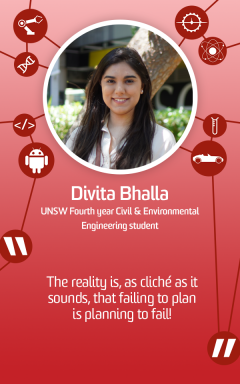
Divita Bhalla, Fourth-year Civil and Environmental Engineering Student
ENGG1000, CVEN3202, MECH1300, ENGG2600, … we are all familiar with these 8 strings of numbers and letters. “Are you doing ENGG1300?”, “Have you done MATH1231?” – These peculiar sounding course codes have become a first language to us. “Which of these courses go with which?”, “what comes first?” and “what order do they go in?” are a fraction of the questions I had when I started studying here.
Planning your degree can sound like a daunting task, but as my father always told me “Well begun is half done!” I will give you some tricks of the trade so that you do not make the same mistakes I made.
Tip number 1: Plan ahead
Do not leave anything till the last minute or enrol term by term, this is a stressful way to start your degree. The reality is, as cliché as it sounds, that failing to plan is planning to fail! Plan, plan and plan some more! Start with your degree handbook or advised enroment sequences – it has a handy skeleton of degree plans. This is helpful to get started. Remember, you can chop and swap courses as they suit you, but actively check term offerings and prerequisites.
It is important to understand the rules are for progressing in your degree and program structure. Find out more here.
Generally, an Engineering degree is 168 UOC Stream + 12 UOC General Education + 12 UOC Electives + 60 Days of IT
Remember to plan to time for an internship or two for your Industrial training! Did you know can take a term off to complete your 60 days of industrial training in one term and maintain full-time study load! Apply for ENGG4998!
Tip number 2: Have a plan B
Once you are done planning, make a plan B and maybe even a plan C! Courses fill up really fast, and you are likely to, at some point in your degree, face a situation where a course fills up before you can enrol. In this case, it is valuable to have a chosen alternative. Whether this is choosing Gen-Eds or Professional Electives, know what your alternative plan is! It is also useful to download a progression plan checklist, and fill one out every once in a while, to confirm you are on track with your degree.
Tip number 3: Make an excel document
Thirdly, make a soft copy of your degree plan. If you are old-school like me, and prefer to use a good old pen and paper, go ahead, but scan a copy and save it, because a single sheet of paper is very easy to lose over 4 years! Excel or even Word are perfect places to make a fun flow-chart or table to visualise time.
Tip number 4: If in doubt, Reach out!
Finally, talk to your seniors! Make friends with students who are ahead of you in the degree; this will give you direct access to “insider information”, as they will be the ones who know what courses go well with each other. Very often, senior students will even be able to tell you which assessment you should spend more time on, or may even be able to give you study tips specific to a course.
You can also reach out to your school contact or Industrial Training office if you need further assistance.
It is never too late to get organised. It is a big relief to go back to a single timeline and know where you are headed. Your future self will thank you for spending a little bit of time on this from the start.

